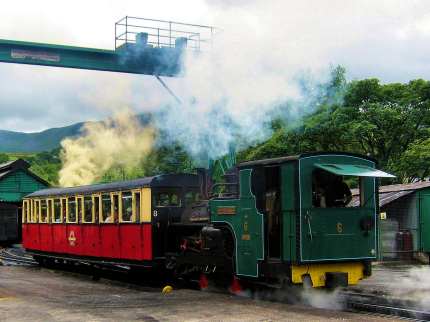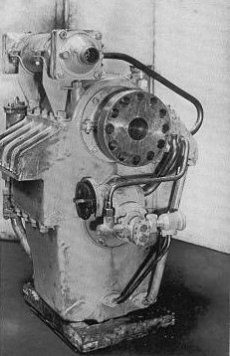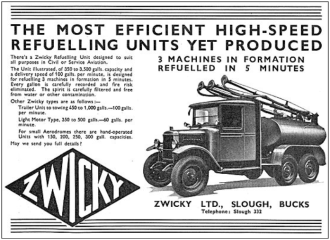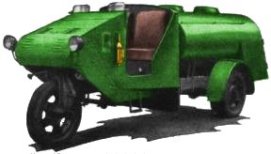
Industry at War part 1
Slough industry, like industry across the country, was seriously affected by World War Two. Men of fighting age were called up to serve in the armed forces all over the world. Some were in reserved occupations such as workers in the power station or working on vital engineering work or food production in factories. Some factories had to adapt from their normal activities to producing components for the war effort.
Slough Trading Estate was buzzing with activity and many companies were engage in the aviation industry in one way or another. The diversion of some companies to aviation from their pre-war activities left them in state that was difficult to recover from post-war as technology in their field had left them behind. Other companies thrived even beyond the war.
Modern Wheel Drive
No direct connection to Modern Wheel Drive and certainly none with Slough. Just an excuse to show one of these charming locomotives. This is 0-4-0 steam locomotive No 6 Padarn built in 1922 and is fitted with an SLM gearbox.
Part of the manufacture of these steam locomotives included the gearboxes. Modern Wheel Drive (MWD) was formed in the 1920s in Slough with a licence agreement to produce SLM gearboxes along with the marketing rights for them within the British Empire whilst SLM would continue to supply the rest of the world.
Some MWD gearboxes manufactured in Slough were particularly supplied to Davey Paxman & Co Ltd for their marine engines. Some of these boxes were made under a further licence by Ruston & Hornsby at Lincoln and possibly other manufacturers. The gearboxes were used in Paxman engines installed in small ships, trawlers and tugs etc.
Landing Craft Tank
From 1941 the Allies began early preparations were begun for the invasion of Europe and a key vessel for this task would be landing craft of varying types. All British Landing Craft Assault (LCA) used for carrying troops were powered by Ford petrol engines. There several marks of British Landing Craft Tank (LCT) that saw service in the Second World War. Some were powered by petrol engines but the vast majority were powered by diesel engines.
A large number of the diesel engines for Landing Craft Tank were built by Paxman and these had MWD reduction gearboxes. The early gearboxes were built by Ruston & Hornsby of Lincoln under licence from MWD. The factory could produce ten to twelve units a week and it soon became clear that this wouldn’t be sufficient to meet the coming demand.
The solution was to increase the small manufacturing plant on Slough Trading Estate. Up to that time the facility was used for the assembly of rotary compressors, and vacuum pumps for railway braking systems. Administration offices and the drawing office were moved to Springfield Avenue, Chesham, a few miles away and later to a country house at Lindo Lodge, Chesham. In Slough, the acquisition of some adjacent buildings was made and the factory for building more reduction gearboxes to supplement the Lincoln plant.
The solution was to increase the small manufacturing plant on Slough Trading Estate. Up to that time the facility was used for the assembly of rotary compressors, and vacuum pumps for railway braking systems. Administration offices and the drawing office were moved to Springfield Avenue, Chesham, a few miles away and later to a country house at Lindo Lodge, Chesham.
With construction number 3001, the photo shows the first MWD Mk 4 gearbox made at Slough.
In Slough, the acquisition of some adjacent buildings was made and the factory for building more reduction gearboxes to supplement the Lincoln plant.
As setting up progressed in 1942 more machinery was installed such as extra-large lathes, gear cutting machines, a large press and heat treatment among other items. The Mk 8 twin engine input gearbox was wholly designed and built at Slough. It was for a larger size Landing Craft with a twin screw, four engine installation.
Landing Craft Tank (LCT) Mark 2
The LCT Mk 2 was powered by 3×460hp Paxman diesels or 3x350hp Napier Lion petrol engines with 3 shafts giving a cruising speed of 10·5kt. Its load bay had a capacity to carry 5×30-ton; 4×40-ton; 3×50-ton tanks; 9 trucks or 254 tons of cargo. Armament consisted of two single 2-pounder pom-pom or two single Bofors 40 mm guns. Seventy-three Mk.2s were built all during 1941.
An impression of a Landing Craft Tank (LCT) Mk 2
Dimensions
-
Displacement: 535 tons
-
Length: 159ft 11in
-
Beam: 30ft
-
Draught: 3ft 8in (forward)
-
Crew: 12
Here is a list of the first five marks of British LCTs of the Second World War. All of the Paxman diesel powered landing craft would have MWD reduction gear boxes, many of these were built by Ruston & Hornsby at Lincoln.
Mark 1
- Year: 1940
- Completed: 30
- Powerplant: 2×350hp Hall-Scott petrol engine, 2 shafts
Mark 3
- Year: 1941
- Completed: 235
- Powerplant: 2×460hp Paxman diesels or Sterling petrol engines, 2 shafts
Landing Craft Tank (LCT) Mark 4
The Mark 4 was introduced in 1941-1942 for the Royal Navy with 865bbeing completed in that time. It was powered by 2x460hp Paxman diesel engines driving two shafts which would have MWD reduction gearbox fitted inline. The craft had a speed of 8 knots and a range of 1,100nm. It could carry 350 tons of cargo or six Churchill or nine M4 Sherman tanks. Armament consisted of either two single Oerlikon 20mm cannon or two single Bofors 40mm guns.
An impression of a Landing Craft Tank (LCT) Mk 4
Dimensions
-
Displacement: 595 tons
-
Length: 187ft 3in
-
Beam: 38ft 9in
-
Draught: 3ft 8in (forward)
-
Crew: 12
The Mark 5 (1942-1944; 470 completed), Mark 6 (1943-1943; 960 completed) and the Mark 7 (1944; 558 completed) were built in the US and fitted with US Gray Marine diesel engines. At time of writing the author could find no information on the Mark 8 (1944-1945; 31 completed for RN). The Mark 9 was a cancelled project.
By mid-1945 production at the Slough plant averaged twenty Mk 4 and six Mk 8 gearboxes per week. The labour at the time was mostly semi-skilled or unskilled both in the machine shop and assembly bay, with some of them already nearing retirement age. MWD/SLM gearboxes were also made in Melbourne, Australia, under licence along with Ruston 6VCBM marine engines. These would become surplus and sent to the UK where there were already customers for them.
In 1966 Ruston and Paxman were taken over by the English Electric Company. In 1968, EEC was taken over by the General Electric Company. Modern Wheel Drive was obviously part of the deal but the Slough plant was closed and sold.
MWD boxes lent themselves well to the many tugs, fishing vessels and small coastal ships that were needed immediately post war. The design was good and well proven and they were robust and reliable in service and were virtually standard for Ruston and Paxman engines in such applications for many years.
Paxman and MWD were taken over by English Electric who in turn were taken over by General Electric Company. For anyone wishing to learn more technical detail or about key people involved in MWD please click the button:
Many thanks to David Wiltshire for providing the lead on this item and the inspiration to continue with other items that are on the way.
Zwicky Liquid Pump Co
Based for along part of their operations in Slough, from 1910 to 1970 Zwicky produced, among other things, aircraft refuelling bowsers, fire appliances and runway sweepers. From 1937 they began to manufacture pumps and filters.
Zwicky refuelling systems were especially designed to deliver the fuel to the aircraft fuel tanks at a very high rate of flow but safely.
This is an advert for a Zwicky aircraft refuelling bowser from 1936. The advert claims that it can refuel three aircraft at once in five minutes providing the machines are arranged in formation.
The unit had a delivery speed of 100 gallons per minute. The fuel was filtered and free from water and other contamination. Any fire risk due to static electricity was eliminated by the tender design.
A fine study of a Zwicky bowser and crew refuelling a Short Stirling bomber. The advert appeared at the end 1945 and was almost certainly staged for the promotion.
By 1959 the company had become a subsidiary of G and J Weir Holdings Ltd.
Zwicky is a surname that seems to have originated from the town of Zwickl in Bavaria but seems to have spread across the borders of Austria and Switzerland.
My name is Gary Flint. I'm author, photographer & illustrator for Postcards from Slough. If you wish to make any comments on the contents of the website please click on the ladybird below:
Gary Flint
08/03/1961 - 09/04/2019
Postcards from Slough is an independently funded website. We are open to offers of sponsorship from companies that have any connections to the town. To contact us please click on the ladybird below:
Chalvey Community Forum
Postcards from Slough is linked with a local action group the Chalvey Community Forum. The group liaises with various local organisations in order to improve the quality of life for residents in the ward of Chalvey and Salt Hill. To learn more please click on the maidenhair leaf below:
Museum of Berkshire Aviation
I volunteer as a guide at the Museum of Berkshire Aviation. It is a special museum and if you would like to know more about the museum then please click on the motif below:
To learn more about the museums activities while staying within this website click on the tab at the top of the page or on the motif below:
Graces Guide
Postcards from Slough uses some images from Grace's Guide. Click on the button below:
British Listed Buildings
Postcards from Slough contributes material to British Listed Buildings and uses the site for cross referencing purposes. Click on the button below:








